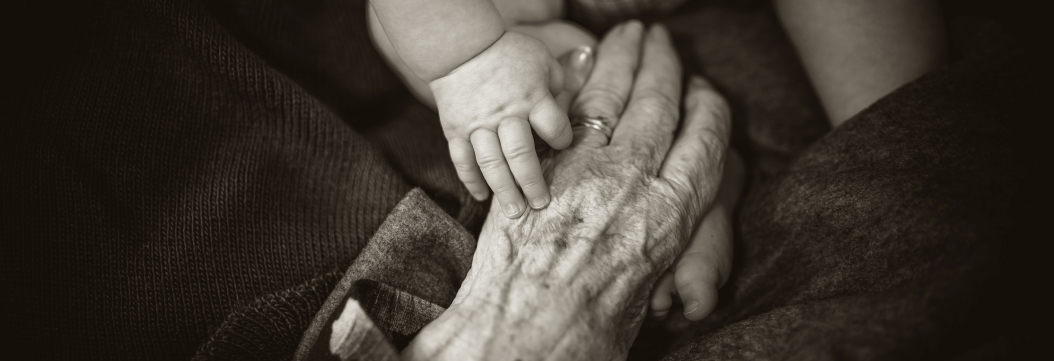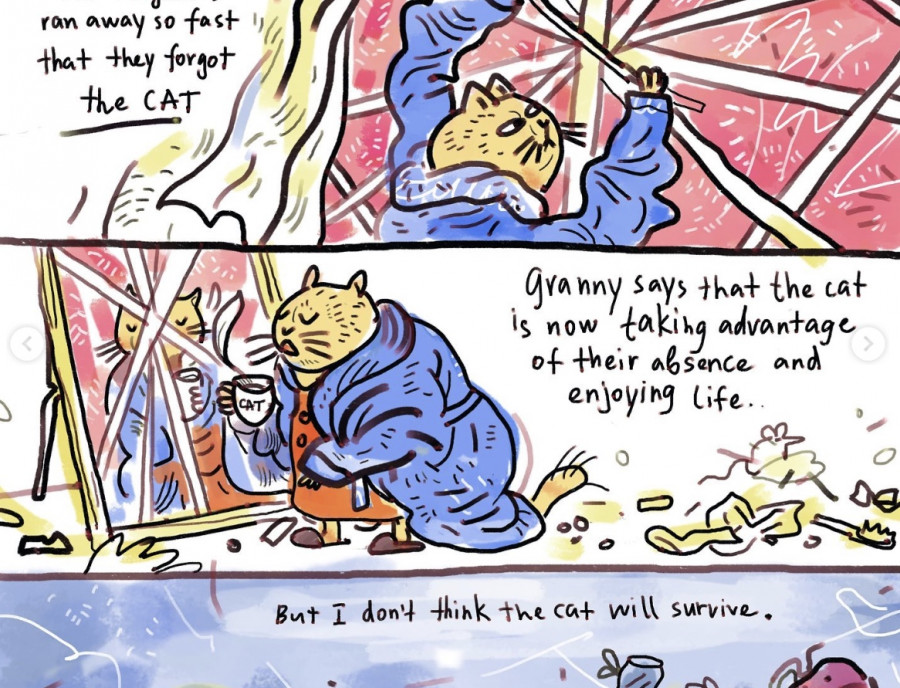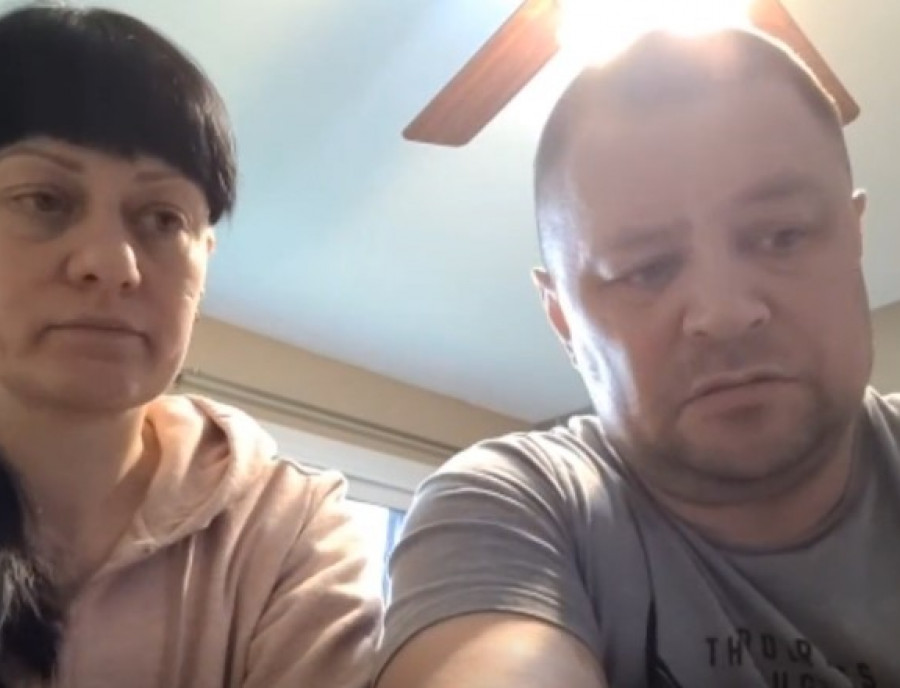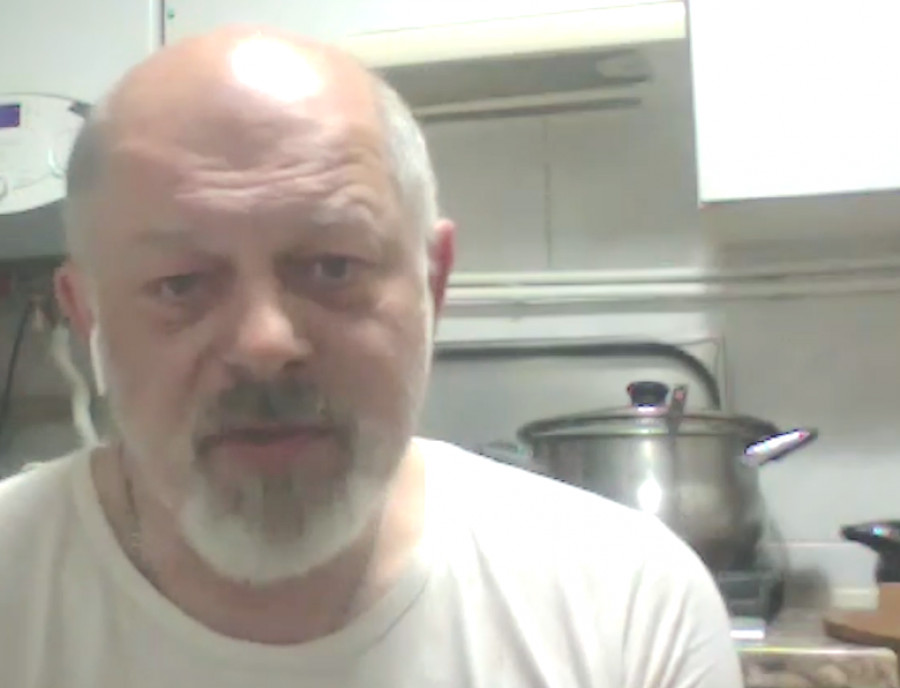Serhiy learned about the death of his children from social networks. On the photos, he recognized the clothes his daughter and son were dressed in. The Perebyinis family lived in Irpin town near Kyiv. They are IDPs from Donetsk. On the eve of the Russian troops’ invasion, the man left for Donetsk to visit his mother who had gone through a severe form of COVID. His wife Tetiana and his children remained in Irpin and died under mortar shelling during the evacuation attempt. Serhiy wants the killers to be brought to justice and punished.
This is a backpack that was on our daughter. Dried blood can be seen clearly. She was wounded in the temple. One can see on those New-York Times pictures that some backpacks were taken off and some were cut off from the bodies. This backpack is cut. It was cut off with a knife. This backpack was on our son. It is all in splinters, and here everything is pierced through with splinters too.
He (the son) took the brunt of the attack with shell fragments. That is, according to the forensic examination, he got multiple splinter wounds from head to toe. Basically, I managed to collect from the scene all the things they had with them. When the children were hit, some civilians evacuated their dead bodies.
The kids died at once and Tetiana died about an hour later. That was the result of a morning artillery shelling.
My name is Serhiy Perebyinis and I am 43 years old. Before the start of all these events, we lived in Donetsk. We can be called native residents of our hometown Donetsk. We were born and raised there. We studied and worked in Donetsk too. In early 2014, with the onset of the “Russian Spring” (let us call it this way), we had to leave the city. It is no secret that there are lots of IDPs in Kyiv region, and in Irpin town in particular.
In our residential compound of 300 flats, about one third of people are IDPs like us, from Donetsk and Luhansk regions. There are a lot of people who found a new place of living and worked fruitfully, developed their families and had kids. People returned to peaceful life after those events they had gone through in 2014-2015 in Donetsk.

Basically, we had the possibility to live normally only the last two years; we returned to peaceful life. After moving into our own flat, we were able to take our minds off the routine, the refurbishment. There are many forest areas around Irpin and we went for a bicycle ride from time to time. We had our friends’ country house where we spent a lot of time. My wife liked to plant flowers, roses. I planted more than 10 trees there and over these years, those small and young trees have grown up. This year 2021 we even collected the first harvest of apples.
On 16 February, my mother, who is still living in Donetsk, called me. We had it in plans to relocate her to Irpin in summer this year 2022. That is we got our timing a little wrong. She was sick with COVID for more than a week. First, the disease was in a stable and controlled form, but then her condition worsened sharply. The doctor diagnosed “bilateral pneumonia”, so I decided to go there, to visit my mother. I had a small individual oxygen concentrator. I put it in a bag, took a backpack with some things and travelled to the occupied territory by bus, through the territory of the Russian Federation.
I came to Donetsk on 18 February. At that time, they began their forced mobilization of local civilians and a choreographed show with the evacuation of people to Rostov region.
Until the last moment, we did not believe that full-scale armed hostilities would begin.
I told my colleagues in Kyiv that most likely, there would be another escalation in Donbass, and since Putin and their government recognized the so-called republics, they would simply try to reach the administrative borders of Donetsk and Luhansk regions. That is, I thought that all this would be happening there. There was no understanding that such large-scale military activities would break out throughout Ukraine.
Starting from 2014, we used Google geolocations. That is, I showed my location to my wife, and she showed me hers. Because in 2015, I had to go to Donetsk very often, in order to collect our belongings, to bring some medicines to my mother, etc. And quite often I could get in, let’s say, some kind of troubles at checkpoints. I came under mortar shelling, and sometimes I was in a zone where there was no mobile phone signal. So, thanks to the geolocations, we could always “see” each other, because this function is arranged in such a way that even if the phone is disconnected for some reason, a subscriber will still see the last location of the person he or she is following.
On 5 March, at 10 o’clock in the evening, we managed to get through to each other. We discussed a plan of the evacuation from the town. Evacuation by car was in priority. That is, leaving the town by car; and the car was already packed and ready.
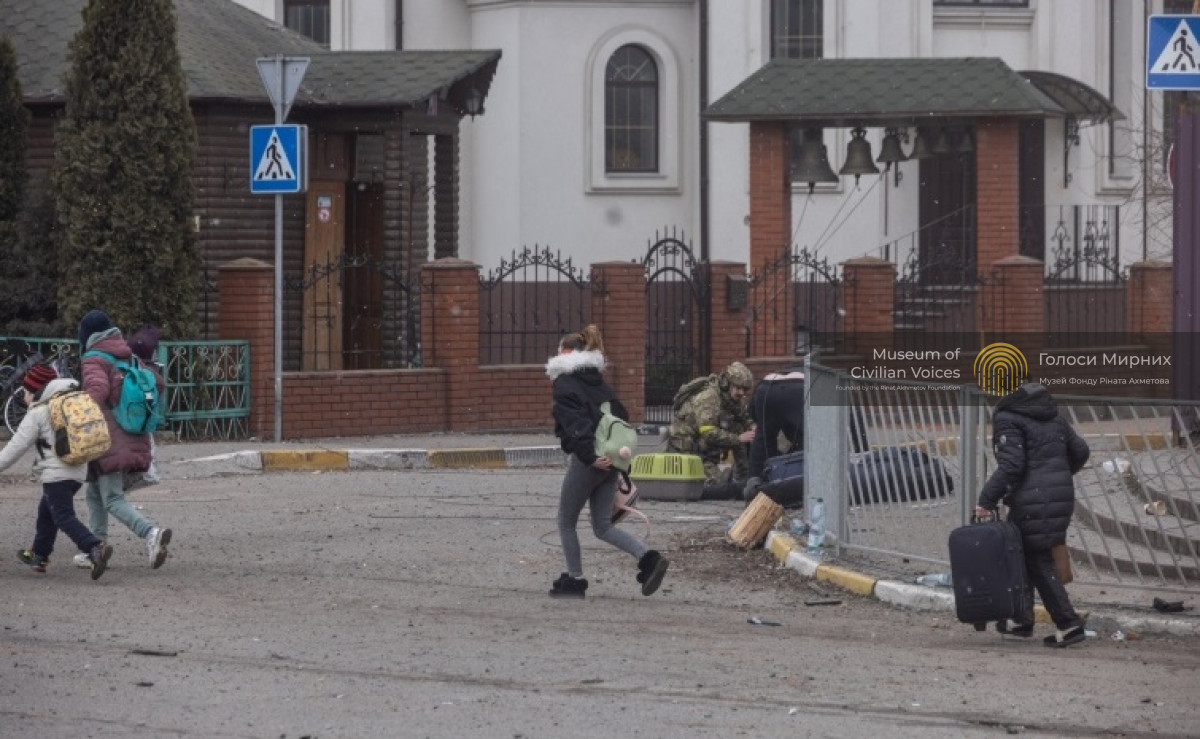
Tetiana and Mykyta already attempted to leave the town on 5 March, but as the fighting began outside, they just went to the basement. It did not work out to leave, so the car was a priority. On 6 March, a group of about 12 cars from the neighbouring residential compound tried to leave the town.
At that time, the only route was to go via Stoyanka and reach the Zhytomyr highway. (I know a reliable information now, because there are some eyewitnesses who survived and posted some videos and some photographs of what happened.) As it turned out, that group of cars came under the hail of fire from Russian soldiers in Stoyanka. The first four cars were completely destroyed and several families died.
I even tried to contact some of those people.
Some of them managed to turn their cars and go back to Irpin town. They then reported that there was no point in going there. So, the second escape route was via Romanivka, under the blown up bridge.
Therefore, they left the car to the neighbour who drove it back to the residential compound. My wife and children were going first, also carrying with them a basket with two dogs inside it. My wife’s father was walking a little behind them, rolling a wheelchair with Tetiana’s mother in it. She is in the first group of disability. She has Alzheimer’s disease and needs constant care. They were a little behind at that moment.
And when they walked along the road, approaching the bridge, the first mine landed to their right, in the floodplain of the river. As Tetiana’s father said, she and the children ran forwards in order to hide under the bridge, and she shouted to him, “Dad, catch up!” But with the wheelchair, it was hard for him to carry her his wife over a metal fence. So, he loitered a little, and some men were helping him with the wheelchair, where my mother-in-law was.
At that moment, the second mine landed right near the bridge – where people were hiding, as far as I know from those video materials that journalists provided to me.
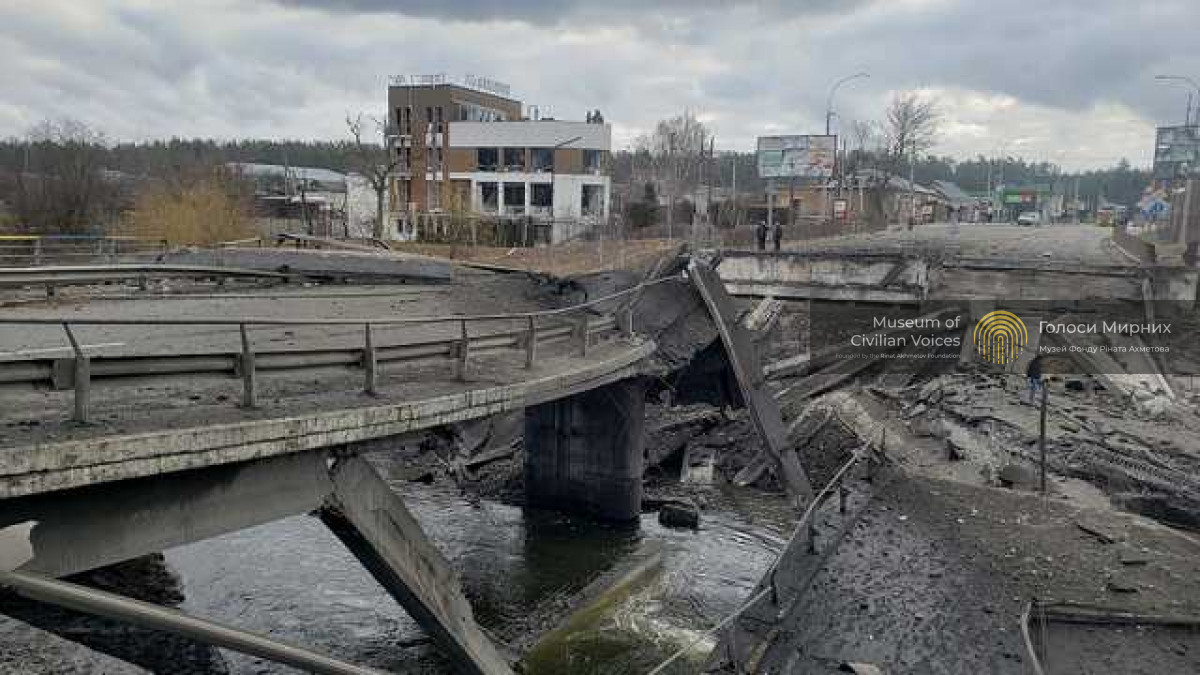
There, under the bridge, a mother with a child were wounded with shell fragments.
This event probably became the key one. They should have waited until the shelling ended, but a chain of people ran through this bridge in panic to Romanivka. And the second video that New York Times journalists provided to us, clearly shows a moment when my family was running along the street to the bus. At that moment, a mine landed and the dog yelped...
I traced all this by the phone, by geotags. That is, I saw that they started moving; their phone went online. There was no mobile phone signal in Irpin at that moment, and 15 minutes later, the phone moved to hospital no.7 in Novobilychi.
I had the first suspicion then: something was going wrong.
I called my colleague and asked him to go to hospital no.7 and find out what was happening. At that moment, my children’s phones were offline. They were not picking up. Tetiana’s phone was online. It was receiving calls, but no one was picking up.
Literally some 15–20 minutes later, the first text entry of some journalist appeared on Twitter saying that mortar shelling was taking place in Romanivka, that civilians came under shellfire during the evacuation and a family was killed.
After another 15–20 minutes, the first photo from the scene appeared on Twitter, and this photo showed the bodies of my children lying on the ground, their faces were blurred.
I fully identified them by their belongings, their clothing, by these suitcases. Also, the pet carrier for dogs had certain colours... It was them clearly.
But my wife was not in that photo. I called those friends in Kyiv who were going to the hospital and said that the children were lying dead on the asphalt road. I asked them to find Tetiana. I managed to get through to the border checkpoint, the one belonging to the so-called DPR on the occupied territory, called Uspenka, and the operator said that they would let me out. He said they had nothing against me. I described my situation to him and he said, “You may have a problem to pass through the MGB checkpoint (Ministry of State Security of the so-called DPR), which is located in Uspenka on the highway.”
We just drove there by car, our car was stopped and we were asked to get out. They took my passport and said, “Where are you going? You are subject to mobilization.” I plainly held my hands out,
“I have nothing to lose, you can detain me right here. My whole family died near Kyiv during the evacuation.” To which he asked, “Who killed them?” I said, “Can you guess who? This is what is called a special operation. We call it war.”
And five minutes later, these people let me go.
Later, a short video appeared where a military medic shouted that she still had a heartbeat. Tetiana was loaded into a car and taken to the hospital. I realized that she was still there and still alive. In the hospital, she remained alive for some time, but she died without regaining consciousness. Although my friends were afraid to tell me about it. I was on the road for four days, but during the first 20 hours of my travel, I only knew that the children died. I knew that my wife was in the hospital, although she was already dead at that time.
My goal is to see justice done. I understand that this is a war crime.
I have already been in the prosecutor’s office and they have opened a criminal case. There is a separate article of the Criminal Code of Ukraine on violation of the rules of warfare. Now the prosecutor’s office of Kyiv region is establishing the witnesses and victims. In my case, as they said, this is a separate legal proceeding on the fact of the group death of one family. Then these cases will be merged together into a single case where all the facts of the deaths of all Ukrainians, all children, will be collected.
And I gave my personal consent that my case, along with other cases of Ukrainian citizens, will be taken to the European Court of Human Rights or other international organizations. I think that in this case it should be the death penalty, preferably not a quick one. No matter how cynical it may sound, these people should be convicted as war criminals, and they should not be serving their sentences in prison.
I propose to return to the Middle Ages for a while. This is my personal opinion. I do not have any feelings for these people, and I stand for such revenge.
When quoting a story, a reference to the source – the Museum of Civilian Voices of the Rinat Akhmetov Foundation – is mandatory, as follows:
The Museum of Civilian Voices of the Rinat Akhmetov Foundation https://civilvoicesmuseum.org/
